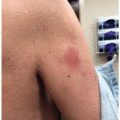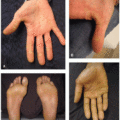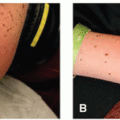Topoisomerase Inhibitors
Abdulhadi Jfri
Christopher Iriarte
Victor Huang
Topoisomerases are enzymes involved in DNA structure, specifically in breaking and rejoining the phosphodiester backbone of double stranded DNA.1 Topoisomerase I inhibitors bind to one stand of DNA and include the camptothecin derivatives: irinotecan, topotecan, belotecan, and camptothecin.1,2 Topoisomerase 2 inhibitors bind both DNA strands and include the anthracyclines (Chapter 25) (doxorubicin, daunorubicin, epirubicin, idarubicin), teniposide, etoposide, and mitoxantrone. Topoisomerase inhibitors are frequently employed within chemotherapy regimens due to their cytotoxic effects. Type 1 inhibitors are most commonly used in treatment of solid organ malignancies, whereas type 2 inhibitors are used to treat hematologic malignancies as well as solid tumors.1
The most common cutaneous adverse effects of the topoisomerase inhibitors as a class include alopecia and mucositis. Alopecia is most commonly observed with the anthracyclines and etoposide and is less common with liposomal delivery.1 Mucositis can affect any part of the gastrointestinal system and may present as oral ulcerations, diarrhea, or both. Erosions and ulcerations of the lips and oropharynx typically develop within the first 5 days of therapy.
Following alopecia and mucositis, maculopapular rash/morbilliform exanthem is reported in up to 16% of patients on topoisomerase 1 inhibitors and 20% of patients on topoisomerase 2 inhibitors.1 Intertriginous eruptions (Figure 24.1) are reported, as are follicular eruptions, pruritus, and severe cutaneous adverse reactions such as erythema multiforme, Stevens-Johnson syndrome, and toxic epidermal necrolysis.1
Stay updated, free articles. Join our Telegram channel

Full access? Get Clinical Tree







